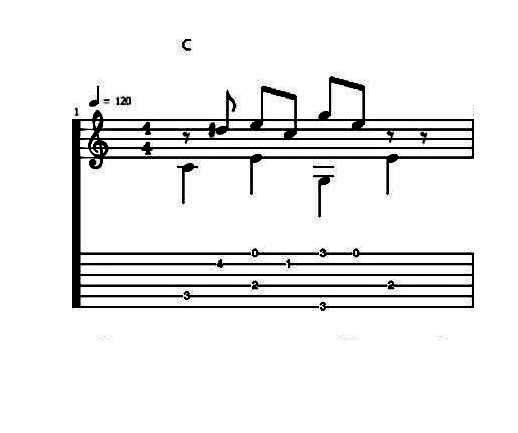
Start with a C chord--and a strong left pinky!
Chapter 10
JORMA MADNESS--or, The Legacy of Reverend Gary Davis
He was also a great adventure for us rebellious adolescents--oh, Excuse Me, I mean us "sensitive, alienated youths of the 1960s, fighting for a better world," etc. It must have driven our middle class parents mucho wacko to watch us running off first to Harlem, and then to a funky part of Queens to study with this blind black master musician--Rev. Davis.
My dad in particular kept hinting that I should already be thinking ahead about graduate school.
Who needed grad school? Rev. Davis was not only the greatest gospel guitarist and singer, a terrific technician on the guitar, and deeply religious--but also a good teacher. He really inspired us to learn (by ear) all sorts of odd, bluesy syncopated pieces.
Maybe it was because he played 'em so great, and we could actually watch him working on them. He'd start out by playing a piece. Then he'd simplify it if we couldn't get it right. In effect, he was contantly "analyzing" the different chord challenges in it as he taught it, and offering alternatives on the fly. Whew.
One Davis-influenced piece that filtered down through the New York blues guitarists was Saturday Night Shuffle, which my teacher Dave Van Ronk taught me.
This piece may have started the New York rounds as an instrumental from an early Merle Travis album. But by the time it was shown to me it had lots of Rev. Davis trademark licks, useful for "ragtime in C." Let's look at a few of these standard licks--licks you'll use over and over again in different pieces.
Measure 1

Start with a C chord--and a strong left pinky!
Beat 1: On-beat play bass note on 5th string. Then streeetch left pinky to 2nd
string fourth fret for Off-beat.
Beat 2: Release pinky, play 4th & 1st strings together. Add 2nd string on
Off-beat.
Beat 3: Pinky on 1st string 3rd fret, play this with bass on 6th string (move
your
left ring to it). Off-beat--open 1st string.
Beat 4: Just Bass
Measure 2
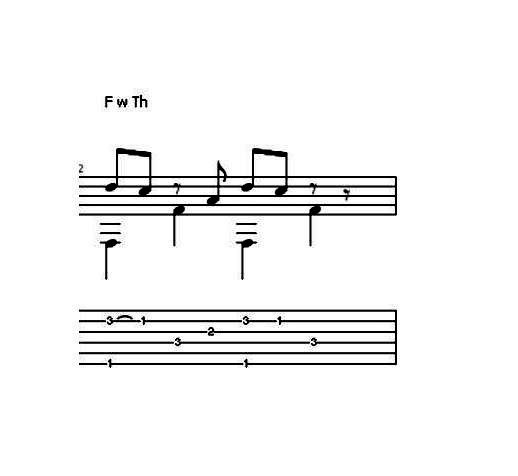
Beat 1: Bass on 6th. Off-beat: pinky plays 2nd string third fret, the PULLS
OFF.
Beat 2: The pull-off ends with alternate bass. Off-beat: 3rd string.
Beat 3: pinky back on 2nd string third fret, but NO pull-off this time. Just
play
it, and then on the off-beat play the string w/o pinky.
Beat 4: Bass
Measure 3 repeats measure 1 (thank goodness), then we have two very quick
chords:
Measure 4:
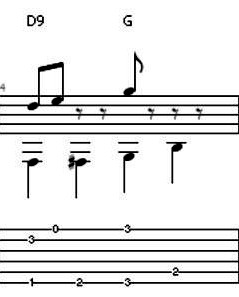
Beat 1: Play a D9:
Use your Thumb or Index for the Bass here
Beat 2: Move whatever's on the 6th string up to the second fret for this
note.
Davis used Left Thumb for bass of beats 1 & 2.
Beat 3: Ordinary G chord here.
Beat 4: Notice the note on 5th string.
This is the bulk of the hard parts of this piece.
Measures 5 and 6 repeat measures 1 & 2 exactly.
Then there's a nifty treble run:
Measure 7
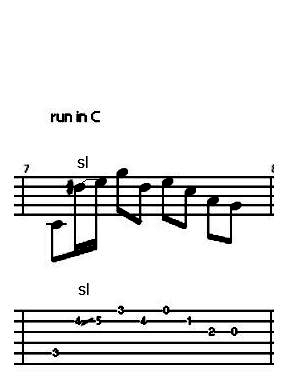
Finally, you may have to reverse the "Right Thumb/Right Index" order here and there to make it work. For example, Beat 2 of this measure.
Beat 1: Bass note. On Off-beat jump to 2nd string fourth fret with left ring,
and
slide it to fifth fret. This starts the run.
Beat 2: 1st string third fret with index. Off-beat: play 2nd string fourth fret,
middle finger
.
Beat 3: Open 1st string. Off beat: 2nd string first fret.
Beat 4: Second fret, then open on 3rd string.
Part II is really a lot easier.
Part III has a neat syncopation for its first two measures, but only one
pull-off.
However, in Measure 3 we get all new chords:
A diminished 7th:
Then jump right to a new B7
I'll call it the "Odd B7":
Next chord is the "odd C7" is the "odd B7" moved up one fret higher.
Measures 7 & 8 end the bridge with more left pinky work:
In Measure 8:
Beat 1: Start with normal G, but on off-beat move your Left Index to the second
fret
of the 1st string. Remember to take your pinky off the same string!
After playing the Bridge, repeat Part I again.
VERSE VERSE BRIDGE VERSE
This is a very important structure! Many jazz-based songs follow this
"form."
The first, second, and last verse have almost identical chords (and chord
sequences). In between the second and the last verse is a Bridge of different
musical material and chord sequence.
Musicians often refer to this structure as:
" A A B A"
because the verses ("A") are similar in chord patterns, while the bridge
("B") is a contrast.
Notice that in Saturday Night Shuffle, Verse I and II have the same chord
patterns
at the same relative measures--even though the notes are different. (Whaaa?).
Or, we could say that the same chords sound at the same time in the two
verses.
For example, Measure 4 of each verse has the "D7 to G" chord sequence.
It's expressed differently in the two verses, but it's the same chord sequence.
Again, Measure 7 in each verse has a "run in C."
In this piece, Verse III just repeats Verse I. In other "AABA" songs,
verse III may
have a new melody--but it'll still be nearly musically identical to the other
verses' chord patterns.
"So what does all this have to do with Jorma Kaukonen?"
you're probably asking by now....
Jorma is perhaps the most famous Rev. Davis influenced guitarist. His version
of Keep On Truckin', a standard pop tune in a 1930s style, has a lot of Davis-style
licks in it. It's a good vehicle for starting to learn this bluesy type of
ragtime guitar. Let's look at it.
Just before Measure 1 comes an intro lick using "harmonized sixths."
Use the Left Ring and Pinky (although you can substitute Left Middle and Ring): One-and Two Three Four is how you'd count the beats here.
Measure 2 is somewhat schizoid:
Measure 3 is full A
Measure 4 starts with a C7 moved up two frets (to become a D7)--Third to Fifth
frets.
Measure 5 again uses the "sliding sixths" in the intro measure of the
piece:
Practice this measure by itself a few times, to get it smooth.
Measure 5 has the same "C to Schizoid C" chord change as Measure 1.
The picking is
different--maybe a little easier.
Measure 7 has the Full A--same as some of our earlier pieces. However, Jorma
flicks his left wrist into a fancy "sixteenth note pull-off":
Beat 2: While playing the alternate bass, pull off the Left pinky from 1st string
fifth fret to the Left middle on the third fret.
Measure 8 has the new D7 (C7 up two frets) again, but this time for nearly the
whole measure. Use the same alternate bass approach we use for the C chord.
Measure 9: This gets a bit wacky. The G7 chord here actually starts with a 5th
string bass. But the bassline calms down by Beat 2 and returns to a normal G/G7
bass:
Measure 9:
Fortunately, measure 9 through 11 are blissfully predictable.
In fact, Measures 9-12 is an oft-used chord sequence for a Bridge:
Measures 14-16 are the last verse, and repeat the tricks we've just covered above.
Keep On Truckin' is another good example of an "A A B A" or
Verse-Verse-Bridge-Verse musical form. Use the link above if you want to polish up the feel of it.
Or better yet, go see Jorma live and shout for it!
More info/contact Andy:
www.andypolon.com
None of the syncopated challenges of Part I, but the same chord structure. Note
the "New D7" in Measure 4. That'a normal C7 moved up two frets, to the
third through fifth frets.
There's a treble run in Measure 7 of Part II as well:
Beat 2: 1st string 3rd fret, then 2nd string fourth fret on Off-beat.
Beat 3: Open 1st string, then 2nd string first fret on off-beat.
Beat 4: Second fret to open on 3rd string.
It's on the fourth and fifth frets, first four strings.
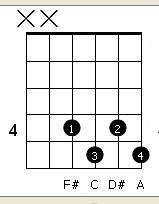
"Roll" your Right hand fingers to play in this order, first Right Thumb, then I, M, R
![]() It's on the second and fourth frets. Index on the first string, middle on the forth string fourth fret. Left Ring on Second string, Fourth fret.
It's on the second and fourth frets. Index on the first string, middle on the forth string fourth fret. Left Ring on Second string, Fourth fret.
![]()
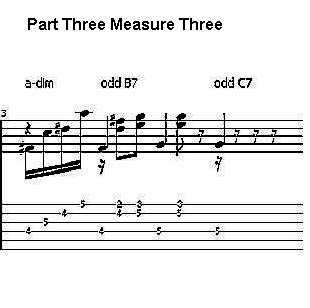

The pinky moves around on the Off-beats in Measure 7:
Beat 1: On off-beat, move it to the 3rd string third fret.
Beat 2: On off-beat, again play the 3rd string third fret.
Beat 3: On off-beat, play 2nd string third fret.
Beat 4: On off-beat, play 2nd string, but now open.
Beat 2: On off-beat, finger a normal G7 for the 1st string note.
Saturday Night Shuffle
Part 1
Saturday Night Shuffle
Pt 2
Saturday Night Shuffle
Pt 3


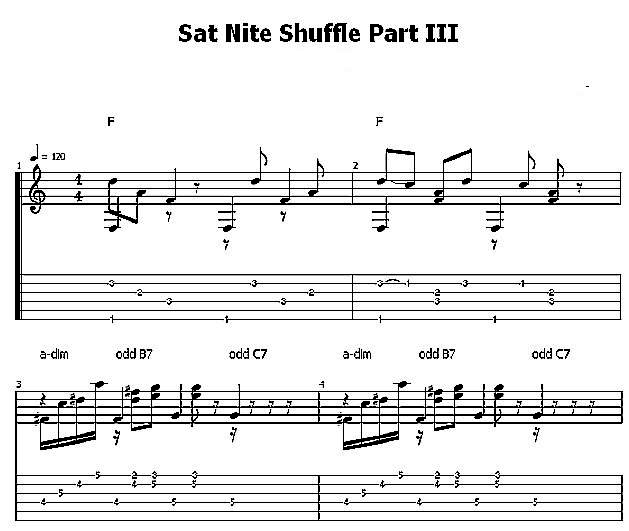
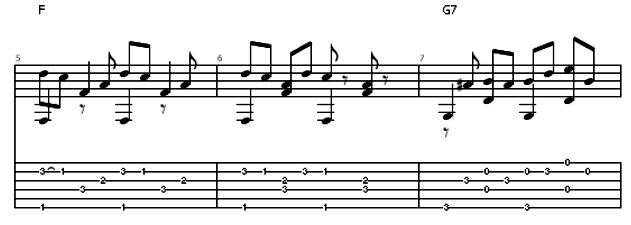

To Part I
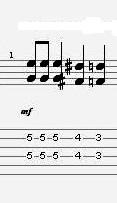
Start with a C chord. On Beat 3 it immediately "mutates."
At this point you've replaced Left Ring with Middle on the 5th string, second fret.
This also leaves the 4th string open.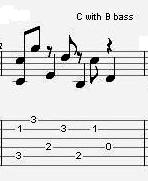
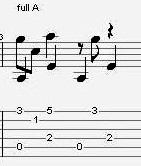
On Beat 3, shift to a normal G7.


Beat 2: Again, Left Ring (on 4th string) and Pinky (on 2nd string), both on the
same
fret. Slide them up to the fifth fret while plucking the 4th and 2nd strings
simultaneously.
Off-beat: play open 1st string.
Beat 3: Back to the Ring and Pinky--now play those sixths on the third, then the
fourth frets.
Beat 4: Just two notes, as if you were on a Chord again.
(Full A)

Off-beat: play 2nd string (Left pinky on it, fifth fret).
At the very end of the measure, release the chord to put your Left Index on the
5th string first fret.
This sets you up for the approach to the next measure's "adventures in
G7".
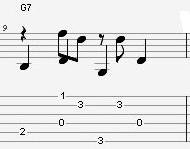
C ---------- C7 ---------- F ---------- ***
where the *** usually contains an Fmi or
D9 chord for added tension. However, in
this piece Jorman uses an Ab7 chord as an interesting substitute. Don't
worry--it's just our "Full A" one fret lower, with
a four string barre on the first fret:

Measure 13: Ab7


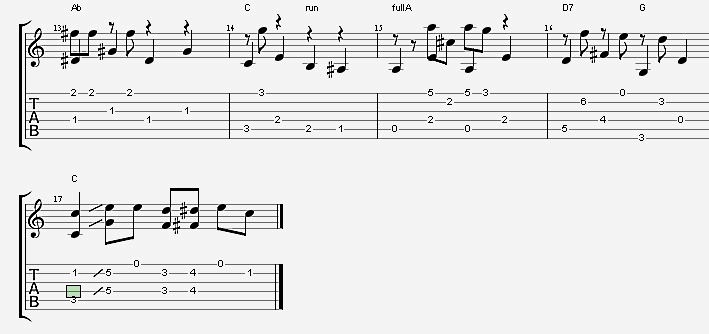
This chapter © 2015 by Andrew D. Polon. All rights reserved.
Back to the
Table Of Contents
Trouble reading tablature?: Tablature Help Here